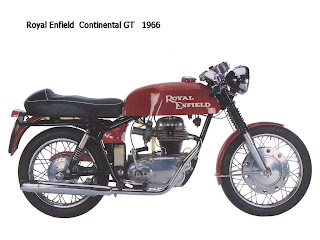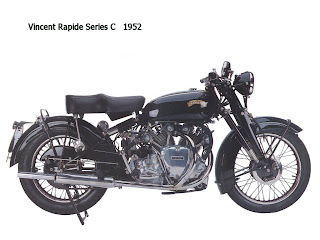
Ας κάνουμε ένα ταξίδι από τις πρώτες προσπάθειες του ανθρώπου να προσαρμόσει έναν κινητήρα σε ένα πλαίσιο και να μπορέσει να κινηθεί σε 2 τροχούς (Dalmer 1885) μέχρι τις σύγχρονες μοτοσυκλέτες. Enjoy !!!!
Μέρος 1ο (1885-1970)
HENDERSON Henderson/ ACE XP4 1923
Bill Henderson founded ACE in 1918, after selling its interests to the Schwinn company in 1917. Ace produced bikes with an in line-four layout, the most known model being the XP-4, which set a world record of 209km/h in 1923. Later, the ACE brand was sold to Indian.
ADLER
The Adler company built its first vehicle in the 1870s, a tricycle. Adler was well-known in the thirties for their fine cars and 3, 3.5 and 5 HP motorcycles. Adler 1902 moto was peroy successful model with different characteristics to meet the requirements of the time. Cars of the 1930s included the Adler Autobahn, Triumpf Junior and the 2.5 liter Glaeser bodied Diplomat. After World War II production resumed in 1949 with a 98cc two stroke motorcycle, followed by improved 147cc, 123cc, 247cc and 195cc designs. The 247cc bike had a modern twin cylinder two-stroke powerplant that had some influence on early Japanese motorcycle engine design. Adler won many races with air- and water-cooled 247cc street racers, driven by Beer, Lohmann, Vogel, Luttenberger, Falk and others. Some all-terrain bikes like the Adler sixdays were built up to 1957. The business was taken over by Grundig in the late fifies and motorcycle production ceased in favour of office equipment, notably typewriters. More specs and user manual of Adler 1902 you can see in next overview.
Ardie
Ardie was a company in Nürnberg, Germany that manufactured motorcycles from 1919 until 1958. The company's name derives from that of its founder, Arno Dietrich.
At first Ardie made motorcycles with its own 288cc and 304cc single cylinder two-stroke engines. In 1925 the company switched to using engines from JAP in London, England. In the 1930s Ardie switched again to engines made by the German companies Bark and Kūchen.
In 1930, Ardie President Willy Bendit assigned German engineer Josef Ganz to build a prototype of a small Volkswagen according to his design. This Ardie-Ganz prototype was finished in September 1930 and achieved highly successful road-test results. The car featured a tubular chassis, mid-mounted engine, and independent wheel suspension with swing-axles at the rear.
In 1936 the company returned to making motorcycles with two-stroke engines of its own manufacture. During the Second World War the company made a model with Ardie's own design of 350cc twin-cylinder side-valve four-stroke engine. After the war the company made a range of single and twin-cylinder machines ranging from 172cc to 344cc.
Ariel
The company dates back to 1847 when Ariel made an early pneumatic-tyred wheel for horse drawn carriages. The name was revived by James Starley and William Hillman in 1870 when they invented the wire-spoke wheel which allowed them to build a lighter weight bicycle and named it Ariel (the spirit of the air).[1] They put the name on the factory where they made penny-farthing bicycles and sewing machines. In 1885 James Starley's nephew, John Kemp Starley, invented the Rover Safety Bicycle - a rear-wheel-drive, chain-driven bicycle with two similar-sized wheels, which is essentially the design still used on bicycles today. Use of the name lapsed but in 1896 it appeared again, this time on motorised transport.
The first Ariel vehicle was a Tricycle that used a 2.25 hp De Dion engine mounted at the rear. More tricycles were produced and motorised quadricycles were added in 1901 as Ariel then moved into car production.
In 1902, Components Ltd., owned by Charles Sangster, bought the company and began producing motorcycles, but the company suffered several financial crises including spells in receivership in 1911 and the early 1930s. In 1932, Components Ltd went bankrupt, and Jack Sangster, Charles Sangster's son, bought the Ariel subsidiary from the receivers at a bargain price. The company was renamed Ariel Motors (J.S.) Ltd, and promptly resumed production.[1]
Bianchi
Bianchi motorcycles were made from 1897 to 1967 by F.I.V. Edoardo Bianchi S.p.A, a company which today is a major Italian bicycle manufacturer, and who also produced automobiles from 1900 to 1939. Edoardo Bianchi started his bicycle manufacturing business in a small shop on Milan’s Via Nirone in 1885. Bianchi was a prominent name in the motorcycle racing world from 1925 to 1930.[1]
BSA
The BSA Golden Flash was a British motorcycle, developed and marketed by the Birmingham Small Arms Company (BSA). The Golden Flash was also available in black and chrome, but it was the all-over gold paint scheme that gave it the name, and made it such a popular escape from post war austerity.
Its development after the 1937 launch of the ground breaking Triumph Speed Twin, together with the need to pay off British war-debt, led to the two creating the post-war rise of the parallel twin engine layout, which was to dominate British design throughout the 1950s and 60s.
Cotton
The Cotton Motorcycle Company, was a British motorcycle manufacturer of 11a Bristol Road, Gloucester, and was founded by Frank Willoughby Cotton in 1918. F.W. presided over the company until his retirement in 1953. The company was reconstituted as E. Cotton (Motorcycles) Ltd, and traded till 1980.
Coventry-Eagle
Coventry-Eagle was a British motorcycle manufacturer. Established as a Victorian bicycle maker, the company began under the name of Hotchkiss, Mayo & Meek. The company name was changed to Coventry Eagle in 1897 when John Meek left the company .[1]. By 1898 they had begun to experiment with motorised vehicles and by 1899, had produced their first motorcycle. The motorcycles were hand built from components and finished carefully, Coventry-Eagle motorcycles proved reliable and by the First World War the range included Villiers_Engineering and JAP engines.[2]
During the early 1920s, the models changed depending on what engines were available and the company swapped between four engine manufacturers. The model Flying 8 was probably the most iconic bike of its time and bore a resemblance to the contemporarythe Brough Superior. During the depression of the 1930s, the company concentrated on producing two-strokes. Production continued until the start of the Second World War in 1939.[3]
Crocker
The Crocker Motorcycle Company was an American manufacturer of single-cylinder speedway racing motorcycles from 1932, powerful V-twin road motorcycles from 1936, and the "Scootabout," one of the first modern styled motor scooters, in the late 1930s. Production ceased in 1942. In 1999 a new corporation was formed to manufacture replica parts, and now produces complete Crockers in kit form, following the original specifications.
Curtiss
Glenn Hammond Curtiss (May 21, 1878 – July 23, 1930) was an American aviation pioneer and a founder of the U.S. aircraft industry. He began his career as a bicycle then motorcycle builder and racer, later also manufacturing engines for airships as early as 1906. In 1908 Curtiss joined the Aerial Experiment Association (AEA), a pioneering research group founded by Alexander Graham Bell at Beinn Bhreagh, Nova Scotia to build flying machines.
Daimler
Gottlieb Daimler (German pronunciation: [ˈɡɔtliːp ˈdaɪmlɐ]; March 17, 1834 – March 6, 1900) was an engineer, industrial designer and industrialist, born in Schorndorf (Kingdom of Württemberg, a federal state of the German Confederation), in what is now Germany. He was a pioneer of internal-combustion engines and automobile development. He invented the first high-speed petrol engine and the first four-wheel automobile.
Daimler and his lifelong business partner Wilhelm Maybach were two inventors whose goal was to create small, high-speed engines to be mounted in any kind of locomotion device. In 1885 they designed a precursor of the modern petrol (gasoline) engine which they subsequently fitted to a two-wheeler, the first internal combustion motorcycle and, in the next year, to a stagecoach, and a boat. Daimler baptized it the Grandfather Clock engine (Standuhr) because of its resemblance to an old pendulum clock.
In 1890, they founded Daimler Motoren Gesellschaft (DMG). They sold their first automobile in 1892. Daimler fell ill and took a break from the company. Upon his return he experienced difficulty with the other stockholders that led to his resignation in 1893. This was reversed in 1894. Maybach resigned at the same time, and also returned. In 1900 Daimler died and Wilhelm Maybach quit DMG in 1907. In 1924, the DMG management signed a long term co-operation agreement with Karl Benz's Benz & Cie., and in 1926 the two companies merged to become Daimler-Benz AG, which is now part of Daimler AG.[citation needed]
DKW
Dampf-Kraft-Wagen (German: steam-driven car) or DKW is a historic car and motorcycle marque. In 1916, the Danish engineer Jørgen Skafte Rasmussen founded a factory in Zschopau, Saxony, Germany, to produce steam fittings. In the same year, he attempted to produce a steam-driven car, called the DKW. Although unsuccessful, he made a two-stroke toy engine in 1919, called Des Knaben Wunsch — "the boy's desire". He also put a slightly modified version of this engine into a motorcycle and called it Das Kleine Wunder — "the little marvel". This was the real beginning of the DKW brand: by the 1930s, DKW was the world's largest motorcycle manufacturer.
In 1932, DKW merged with Audi, Horch and Wanderer, to form the Auto Union. Auto Union came under Daimler-Benz ownership in 1957, and was then purchased by the Volkswagen Group in 1964. The last DKW car was the F102 which ceased production in 1966; after this the brand was phased out.
Douglas
Douglas was a British motorcycle manufacturer from 1907–1957 based in Kingswood, Bristol, owned by the Douglas family, and especially known for its horizontally opposed twin cylinder engined bikes and as manufacturers of speedway machines. The company also built a range of cars between 1913 and 1922.
* Σαφώς και υπάρχουν πολύ περισσότερα μοντέλα και μάρκες από αυτά που έχουν ανέβει στη συγκεκριμένη ανάρτηση.
* Άν κάποιος επιθυμεί να του στείλω ολόκληρο το αρχείο μπορεί να επικοινωνήσει μαζί μου.



























































































































































































































































































Δεν υπάρχουν σχόλια:
Δημοσίευση σχολίου